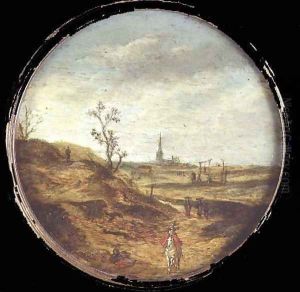Esaias II van de Velde Paintings
Esaias van de Velde was a prominent Dutch landscape painter born in Amsterdam in 1591. As a pivotal figure in the transition from the Flemish tradition of landscape painting to the Dutch Golden Age's more realist and naturalistic style, his work marks a significant moment in the history of art. Esaias was part of a family of artists; his father, Hans van de Velde, was also a painter, though less is known about his influence on Esaias's development.
Esaias was initially taught by his uncle, Pieter van de Velde. However, he later became a student of Gillis van Coninxloo, who was among the last great Flemish painters to influence Dutch art before the onset of the Dutch Golden Age. Under Coninxloo’s tutelage, Esaias was exposed to the Flemish tradition of rich, detailed landscapes populated with small figures. Yet, as his style matured, Esaias started to integrate the Mannerist style into something distinctly more Dutch, focusing on the everyday life and landscapes of Holland rather than the pastoral, often mythological scenes favored by his Flemish predecessors.
In 1612, Esaias moved to The Hague, where he became a member of the Guild of Saint Luke and significantly influenced the development of landscape painting in the area. His landscapes typically featured scenes from the Dutch countryside, including dunes, woods, and rivers, often populated with small figures going about their daily tasks, which showcased a keen observation of local life and light. His work also included winter scenes, which were a popular subject in Dutch painting at the time, and he was one of the first artists to develop this genre.
Van de Velde's influence was widespread, and he taught several students who would go on to become prominent painters themselves, such as Jan van Goyen and Pieter de Neyn. Through his teaching and his innovative approach to landscape painting, Esaias played a significant role in setting the stage for the Dutch Golden Age of painting.
Esaias van de Velde died in The Hague in 1630. His legacy is a body of work that captures the beauty of the Dutch landscape and the simplicity of its rural life, which would resonate through centuries and influence countless artists in the tradition of Dutch landscape painting.


